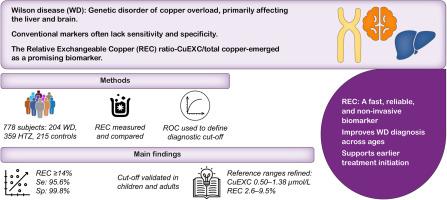Relative exchangeable copper: A highly specific and sensitive biomarker for Wilson disease diagnosis
IF 7.5
1区 医学
Q1 GASTROENTEROLOGY & HEPATOLOGY
引用次数: 0
Abstract
Background & Aims
Wilson disease (WD) is an autosomal recessive disorder characterized by copper accumulation in various organs, primarily the liver and brain. Standard assessment of copper metabolism includes total serum copper, serum ceruloplasmin, and urinary copper excretion. Quantitative measurement of non-ceruloplasmin-bound copper, known as exchangeable copper (CuEXC), was developed in 2009. Subsequently in 2011, relative exchangeable copper (REC), defined as the ratio of CuEXC to total serum copper, was proposed as a diagnostic biomarker. This study aimed to validate the REC cut-off for the diagnosis of WD in a large cohort and to refine the reference ranges for CuEXC.
Methods
Data were collected from 778 individuals at the French National Reference Centre for WD from January 2009 to 2025. The cohort included 204 patients with WD, 359 healthy heterozygous carriers, and 215 controls. All participants underwent clinical evaluation, assessment of copper metabolism, including CuEXC and REC, and genetic testing for ATP7B. Receiver operating characteristic curve analysis was used to assess the diagnostic performance of REC and to determine the optimal cut-off for diagnosing WD.
Results
Patients with WD had significantly higher CuEXC and REC values compared with heterozygous carriers and controls. The optimal REC cut-off for diagnosing WD was identified as 14% with 95.6% sensitivity and 99.8% specificity. This cut-off was validated in both pediatric and adult subgroups with similar sensitivity and specificity. Reference ranges for CuEXC (0.50–1.38 μmol/L) and for REC (2.6–9.5%) were refined using control group data. Age-specific ranges were also determined.
Conclusion
This study supports the use of REC in clinical practice and confirms its central role in the diagnostic algorithm for WD, as recognized in the recently published EASL 2025 guidelines.
Impact and implications
The study established relative exchangeable copper (REC) as a robust diagnostic biomarker for Wilson disease (WD), demonstrating high sensitivity and specificity across age groups in a large cohort including 204 patients with WD. By refining the optimal REC cut-off, this research provides crucial insights for improving WD diagnostic accuracy and patient outcomes. These findings confirm the need to incorporate REC into routine clinical practice and WD management guidelines, potentially reducing the reliance on invasive liver biopsies to assess hepatic copper levels. Consequently, this advancement in diagnostic methodology could facilitate earlier detection and treatment, thereby preventing irreversible tissue damage and enhancing the quality of life for patients with WD.

相对可交换性铜:威尔森氏病诊断的高度特异性和敏感性生物标志物
背景:威尔森病(WD)是一种常染色体隐性遗传病,其特征是铜在各器官(主要是肝脏和大脑)积累。铜代谢的标准评估包括总血清铜、血清铜蓝蛋白和尿铜排泄。非铜蓝蛋白结合铜的定量测量,被称为可交换铜(CuEXC),于2009年开发出来。随后在2011年,相对可交换铜(REC),定义为CuEXC与总血清铜的比率,被提出作为诊断性生物标志物。本研究旨在验证REC在大型队列中诊断WD的截止值,并完善CuEXC的参考范围。方法2009年1月至2025年在法国国家WD参考中心收集778名患者的数据。该队列包括204名WD患者,359名健康杂合携带者和215名对照组。所有参与者都进行了临床评估,评估铜代谢,包括CuEXC和REC,以及ATP7B的基因检测。受试者工作特征曲线分析用于评估REC的诊断性能,并确定诊断WD的最佳截止值。结果WD患者的CuEXC和REC值明显高于杂合携带者和对照组。诊断WD的最佳REC截止值为14%,敏感性为95.6%,特异性为99.8%。该切断在儿童和成人亚组中均得到验证,具有相似的敏感性和特异性。以对照组为基准,确定CuEXC (0.50 ~ 1.38 μmol/L)和REC(2.6 ~ 9.5%)的参考范围。还确定了特定年龄的范围。本研究支持REC在临床实践中的应用,并证实了其在WD诊断算法中的核心作用,正如最近发布的EASL 2025指南所承认的那样。影响和意义该研究确立了相对可交换性铜(REC)作为威尔森氏病(WD)的可靠诊断生物标志物,在包括204名WD患者在内的大型队列中显示出高灵敏度和特异性。通过优化最佳REC截止值,本研究为提高WD诊断准确性和患者预后提供了重要见解。这些发现证实了将REC纳入常规临床实践和WD管理指南的必要性,可能会减少对侵入性肝活检评估肝铜水平的依赖。因此,这种诊断方法的进步可以促进早期发现和治疗,从而防止不可逆的组织损伤,提高WD患者的生活质量。
本文章由计算机程序翻译,如有差异,请以英文原文为准。
求助全文
约1分钟内获得全文
求助全文
来源期刊

JHEP Reports
GASTROENTEROLOGY & HEPATOLOGY-
CiteScore
12.40
自引率
2.40%
发文量
161
审稿时长
36 days
期刊介绍:
JHEP Reports is an open access journal that is affiliated with the European Association for the Study of the Liver (EASL). It serves as a companion journal to the highly respected Journal of Hepatology.
The primary objective of JHEP Reports is to publish original papers and reviews that contribute to the advancement of knowledge in the field of liver diseases. The journal covers a wide range of topics, including basic, translational, and clinical research. It also focuses on global issues in hepatology, with particular emphasis on areas such as clinical trials, novel diagnostics, precision medicine and therapeutics, cancer research, cellular and molecular studies, artificial intelligence, microbiome research, epidemiology, and cutting-edge technologies.
In summary, JHEP Reports is dedicated to promoting scientific discoveries and innovations in liver diseases through the publication of high-quality research papers and reviews covering various aspects of hepatology.
 求助内容:
求助内容: 应助结果提醒方式:
应助结果提醒方式:


